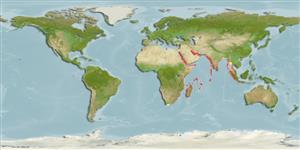Environment: milieu / climate zone / depth range / distribution range
Ecology
Marine; reef-associated; depth range 0 - 85 m (Ref. 104785). Tropical; 30°N - 36°S, 19°E - 112°E
Indian Ocean: Persian Gulf (Ref.80050) and Red Sea south to Port Alfred, South Africa and east to Sumatra, Indonesia (Ref. 33390). Atlantic Ocean. Also known in eastern Mediterranean (Ref. 37421).
Size / Weight / Age
Maturity: Lm ? range ? - ? cm
Max length : 43.0 cm TL male/unsexed; (Ref. 125962); max. published weight: 787.80 g (Ref. 131232)
Dorsal spines (total): 13; Dorsal soft rays (total): 9 - 11; Anal spines: 3; Anal soft rays: 6 - 7. Reddish to tan or grey in color, with numerous thin dark bars on body and head; tentacle above eye may be faintly banded (Ref. 4313). Adults have a band of small spines along the cheek and small spots in the median fins (Ref. 48635).
Adults are found in coastal waters in muddy habitats (Ref. 48635). Minimum depth of 0m (Ref. 81209). Fin spines highly venomous, may cause human death (Ref. 30573).
Life cycle and mating behavior
Maturity | Reproduction | Spawning | Eggs | Fecundity | Larvae
Eschmeyer, W.N., 1986. Scorpaenidae. p. 463-478. In M.M. Smith and P.C. Heemstra (eds.) Smiths' sea fishes. Springer-Verlag, Berlin. (Ref. 4313)
IUCN Red List Status (Ref. 130435: Version 2024-1)
Human uses
Fisheries: commercial; aquarium: commercial
Tools
Special reports
Download XML
Internet sources
Estimates based on models
Preferred temperature (Ref.
123201): 24.5 - 29.3, mean 27.6 °C (based on 328 cells).
Phylogenetic diversity index (Ref.
82804): PD
50 = 0.5005 [Uniqueness, from 0.5 = low to 2.0 = high].
Bayesian length-weight: a=0.01072 (0.00632 - 0.01817), b=3.04 (2.89 - 3.19), in cm total length, based on LWR estimates for this species & (Sub)family-body (Ref.
93245).
Trophic level (Ref.
69278): 4.5 ±0.80 se; based on food items.
Resilience (Ref.
120179): Low, minimum population doubling time 4.5 - 14 years (Preliminary K or Fecundity.).
Fishing Vulnerability (Ref.
59153): Low to moderate vulnerability (33 of 100).
Nutrients (Ref.
124155): Calcium = 43.4 [22.3, 87.5] mg/100g; Iron = 0.586 [0.302, 1.537] mg/100g; Protein = 18.2 [16.2, 20.2] %; Omega3 = 0.218 [0.095, 0.597] g/100g; Selenium = 32.6 [16.5, 83.8] μg/100g; VitaminA = 206 [65, 621] μg/100g; Zinc = 1.04 [0.70, 1.50] mg/100g (wet weight);
